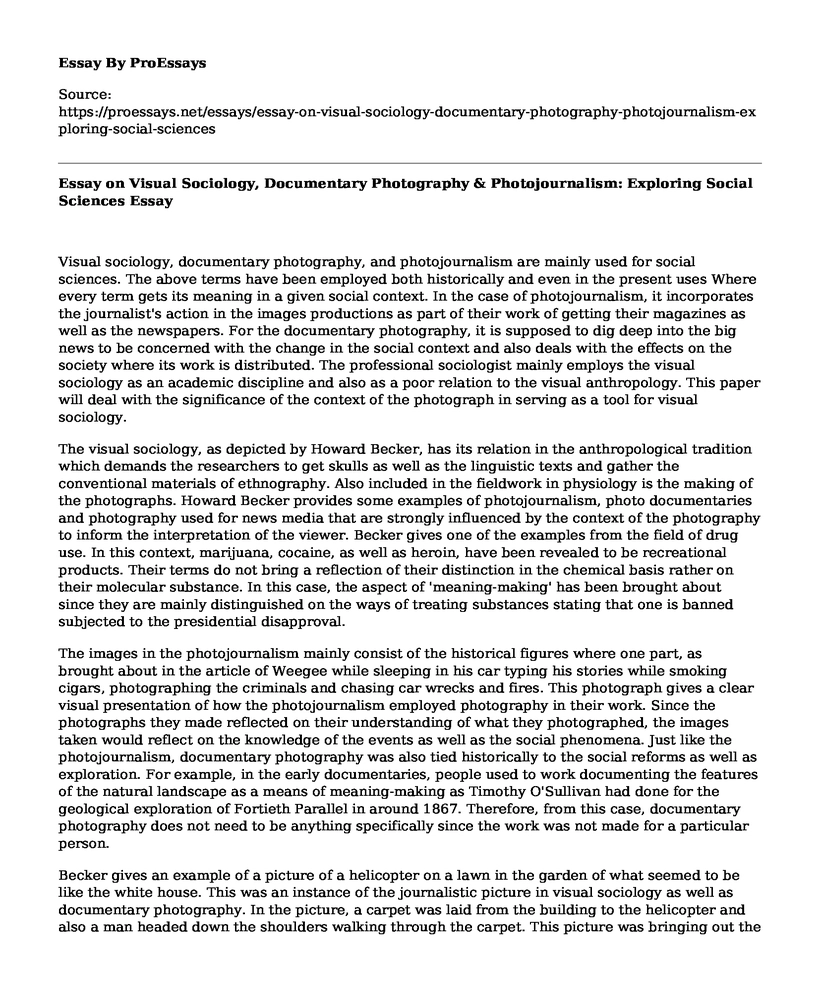Visual sociology, documentary photography, and photojournalism are mainly used for social sciences. The above terms have been employed both historically and even in the present uses Where every term gets its meaning in a given social context. In the case of photojournalism, it incorporates the journalist's action in the images productions as part of their work of getting their magazines as well as the newspapers. For the documentary photography, it is supposed to dig deep into the big news to be concerned with the change in the social context and also deals with the effects on the society where its work is distributed. The professional sociologist mainly employs the visual sociology as an academic discipline and also as a poor relation to the visual anthropology. This paper will deal with the significance of the context of the photograph in serving as a tool for visual sociology.
The visual sociology, as depicted by Howard Becker, has its relation in the anthropological tradition which demands the researchers to get skulls as well as the linguistic texts and gather the conventional materials of ethnography. Also included in the fieldwork in physiology is the making of the photographs. Howard Becker provides some examples of photojournalism, photo documentaries and photography used for news media that are strongly influenced by the context of the photography to inform the interpretation of the viewer. Becker gives one of the examples from the field of drug use. In this context, marijuana, cocaine, as well as heroin, have been revealed to be recreational products. Their terms do not bring a reflection of their distinction in the chemical basis rather on their molecular substance. In this case, the aspect of 'meaning-making' has been brought about since they are mainly distinguished on the ways of treating substances stating that one is banned subjected to the presidential disapproval.
The images in the photojournalism mainly consist of the historical figures where one part, as brought about in the article of Weegee while sleeping in his car typing his stories while smoking cigars, photographing the criminals and chasing car wrecks and fires. This photograph gives a clear visual presentation of how the photojournalism employed photography in their work. Since the photographs they made reflected on their understanding of what they photographed, the images taken would reflect on the knowledge of the events as well as the social phenomena. Just like the photojournalism, documentary photography was also tied historically to the social reforms as well as exploration. For example, in the early documentaries, people used to work documenting the features of the natural landscape as a means of meaning-making as Timothy O'Sullivan had done for the geological exploration of Fortieth Parallel in around 1867. Therefore, from this case, documentary photography does not need to be anything specifically since the work was not made for a particular person.
Becker gives an example of a picture of a helicopter on a lawn in the garden of what seemed to be like the white house. This was an instance of the journalistic picture in visual sociology as well as documentary photography. In the picture, a carpet was laid from the building to the helicopter and also a man headed down the shoulders walking through the carpet. This picture was bringing out the aspect of politics as a form of meaning-making which was happening in the United States in those times. The picture suffered the fate of the photographs in the news. The values of the news were directly dependent on the context as well as its event of being contemporary. In my thinking, the image summed up a story that had been revealed in the media which represented the gradual as well as the inevitable downfall of the political leader.
There are many areas in daily life where the photograph context has a significant influence on the aspect of meaning-making. For instance, an interpretive engagement framework is usually proposed to describe the analytic processes for the participant-generated meaning-making in visual images. In such a framework, the participant-generated photographs form the young people having a chronic illness is used. This brings out the work in visual analytic to be evident and tangible for the reader revealing how the interpretive engagement can support the development of many things especially in the context of visual sociology, documentary photography and photojournalism.
References
Becker, H. S. (1995). Visual sociology, documentary photography, and photojournalism: It is (almost) all a matter of context. Visual Studies, 10(1-2), 5-14.
Newton, J. H. (2009). Photojournalism: Do people matter? Then photojournalism matters. Journalism Practice, 3(2), 233-243.
Carr, D. (2011, June). The Forum: Celebrating the Work of Sebastiao Salgado: A Sociological Lens on Salgado's Documentary Photography. In Sociological Forum (Vol. 26, No. 2, pp. 416-417).
Cite this page
Essay on Visual Sociology, Documentary Photography & Photojournalism: Exploring Social Sciences. (2023, Mar 26). Retrieved from https://proessays.net/essays/essay-on-visual-sociology-documentary-photography-photojournalism-exploring-social-sciences
If you are the original author of this essay and no longer wish to have it published on the ProEssays website, please click below to request its removal:
- Little Bit of Everything Song by Keith Urban - Song Analysis Essay
- Essay Example on Russian Music: From 11th C. to USSR
- Golden Ratio in Le Corbusier's Architecture: A Mathematical Perspective - Essay Sample
- Essay Sample on Malala Yousafzai: Nobel Peace Prize Winner & Children's Rights Activist
- Essay Sample on Social Power: Using Knowledge to Achieve Desired Goals
- Essay Example on The Road to the Coup in Iran: Critical Examinations of Key Players
- Uncovering Community Problems: A Guide to Identification & Solutions - Essay Sample







